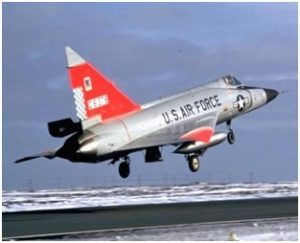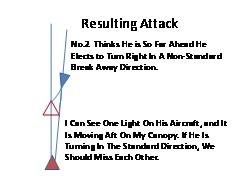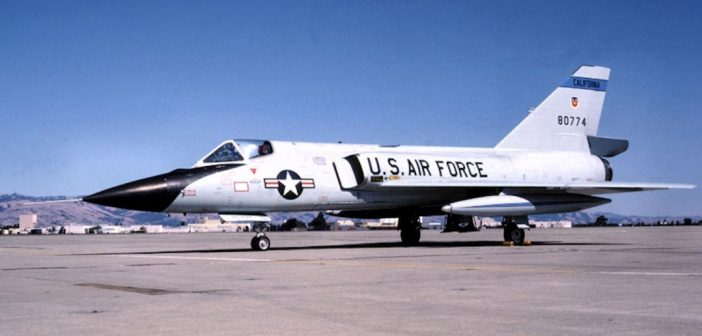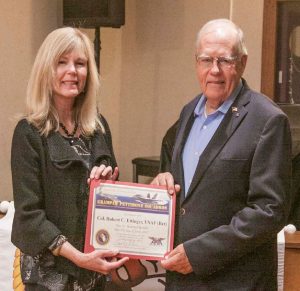The Grampaw Pettibone Squadron was honored to host, Robert C. Ettinger, Colonel – USAF (ret). for the June 2017 meeting.
Colonel Ettinger served 27 1/2 years in the United States Air Force as a fighter pilot, combat pilot, experimental test pilot and flight test manager. His last position in the USAF was Vice Commander of the Air Force Flight Test Center (AFFTC) at Edwards AFB, CA. As a test pilot, he was the first USAF pilot to fly the F-16 Full Scale Development. The Colonel has over 6,600 hours in more than 100 different types of aircraft. He has a Bachelor of Science Degree in Mechanical Engineering from the University of California at Berkeley and a Master of Science Degree in Aeronautical Engineering from Ohio State University.
Colonel Ettinger shared his experience participating in Advanced Air Defense Interceptor Training in the F-102. The assignment and training was based out of Misawa Air Base in Northern Japan. The presentation began with an overview of the F102, a member of the Century Series, and the USAF first operational supersonic aircraft to serve as an interceptor. As a single seat interceptor, it was equipped with the Hughes MG-10 Fire Control System, and armed with up to 3 Radar guided, 3 Infrared and 24 folding fin missiles, all located in an internal weapons bay. The F102 was capable of speeds up 1.25 Mach and a 1000 mile range.
 The Colonel described participating In an interceptor training exercise 100 miles off the coast of Japan. He was the targeted aircraft, flying at 30,000 feet, traveling at 500 knots; the same speed of the interceptor. The interceptor aircraft with GCI guidance was to approach from the nose of the targeted plane at an offset angle and was to be in a position of 110 degrees to the target for the simulated missile launch. The interceptor was to call 20 seconds and the target aircraft to confirm sighting and announce termination of the approach. The interceptor was to terminate and turn left, but instead without announcing, the pilot turned in a non-standard manner to the right and failed to clear the aircraft piloted by the Colonel.
The Colonel described participating In an interceptor training exercise 100 miles off the coast of Japan. He was the targeted aircraft, flying at 30,000 feet, traveling at 500 knots; the same speed of the interceptor. The interceptor aircraft with GCI guidance was to approach from the nose of the targeted plane at an offset angle and was to be in a position of 110 degrees to the target for the simulated missile launch. The interceptor was to call 20 seconds and the target aircraft to confirm sighting and announce termination of the approach. The interceptor was to terminate and turn left, but instead without announcing, the pilot turned in a non-standard manner to the right and failed to clear the aircraft piloted by the Colonel.
 The two aircraft collided and both pilots ejected. The Colonel noted during the presentation that a 6-8 second difference would have resulted in a near miss or a fatal collision. The Colonel related that upon ejecting from his aircraft the automatic features of seat and parachute release did not work. He overcame failure of the equipment operation by manually releasing the lap-belt and opening the parachute shortly after ejecting. The manual release of the parachute at the high altitude coupled with the stormy and turbulent air resulted in a 23 minute descent to the water. The survival equipment that accompanied his ejection was partially damaged or lost during the descent. The raft failed to inflate completely and the Colonel was half submerged in the 56 degree water. The pilot of the
The two aircraft collided and both pilots ejected. The Colonel noted during the presentation that a 6-8 second difference would have resulted in a near miss or a fatal collision. The Colonel related that upon ejecting from his aircraft the automatic features of seat and parachute release did not work. He overcame failure of the equipment operation by manually releasing the lap-belt and opening the parachute shortly after ejecting. The manual release of the parachute at the high altitude coupled with the stormy and turbulent air resulted in a 23 minute descent to the water. The survival equipment that accompanied his ejection was partially damaged or lost during the descent. The raft failed to inflate completely and the Colonel was half submerged in the 56 degree water. The pilot of the  interceptor aircraft was injured during the ejection. Using signal flares to attract attention failed on 3 separate attempts. It took 7 hours for a search team to locate the Colonel. He was rescued by a Japanese Maritime Safety Agency Ship and treated for exposure. The second pilot was located and rescued, some 16 hours after the collision. The Colonel closed his presentation with this observation about the ‘Ettinger Total Luck Quotient’ – “Apparently, you have only so much luck per unit of time. You can spend that luck on trivial things, like bar rolls. Or you can spend it all on one miraculous recovery. Fortunately, a safe recovery was chosen for me.”.
interceptor aircraft was injured during the ejection. Using signal flares to attract attention failed on 3 separate attempts. It took 7 hours for a search team to locate the Colonel. He was rescued by a Japanese Maritime Safety Agency Ship and treated for exposure. The second pilot was located and rescued, some 16 hours after the collision. The Colonel closed his presentation with this observation about the ‘Ettinger Total Luck Quotient’ – “Apparently, you have only so much luck per unit of time. You can spend that luck on trivial things, like bar rolls. Or you can spend it all on one miraculous recovery. Fortunately, a safe recovery was chosen for me.”.





